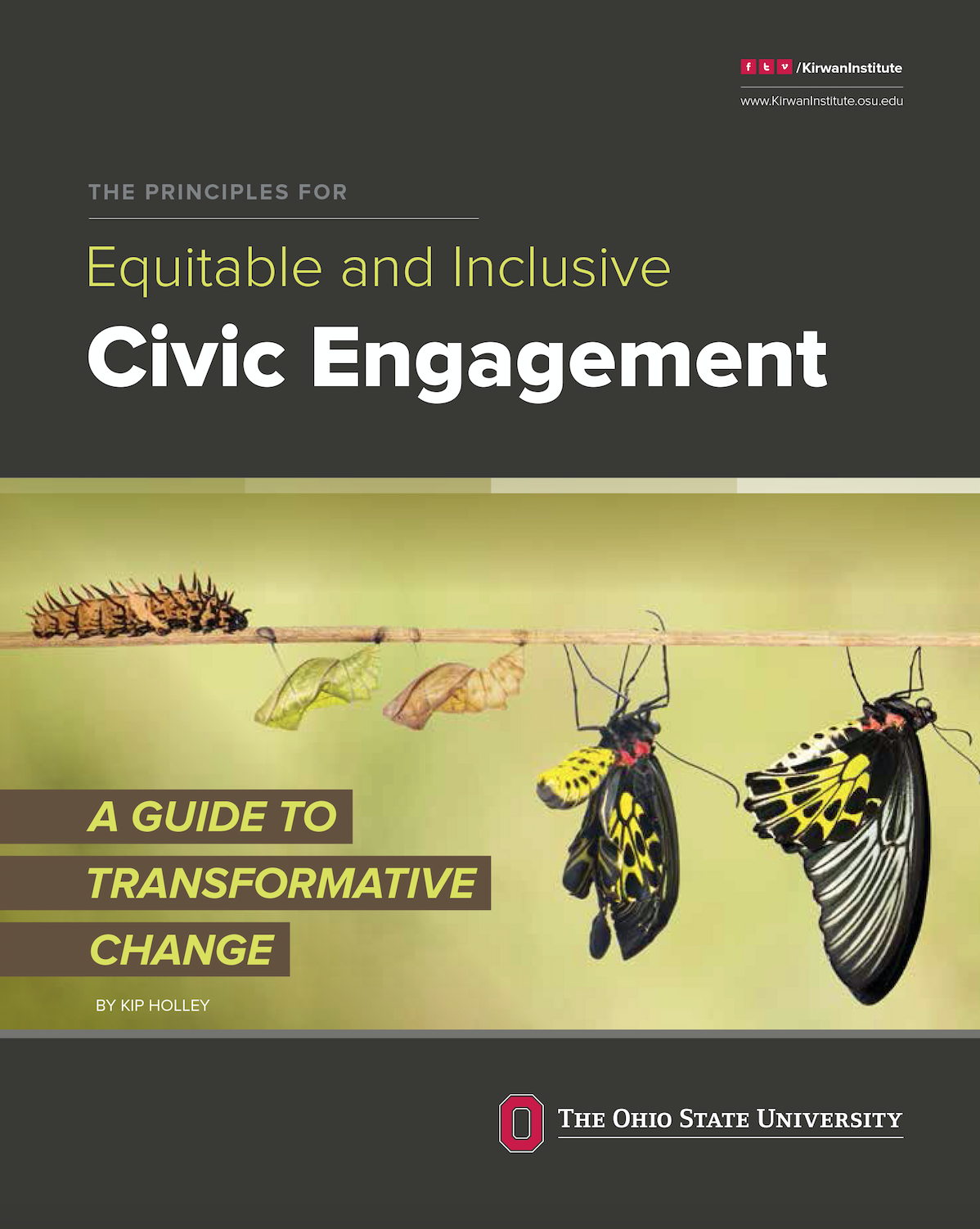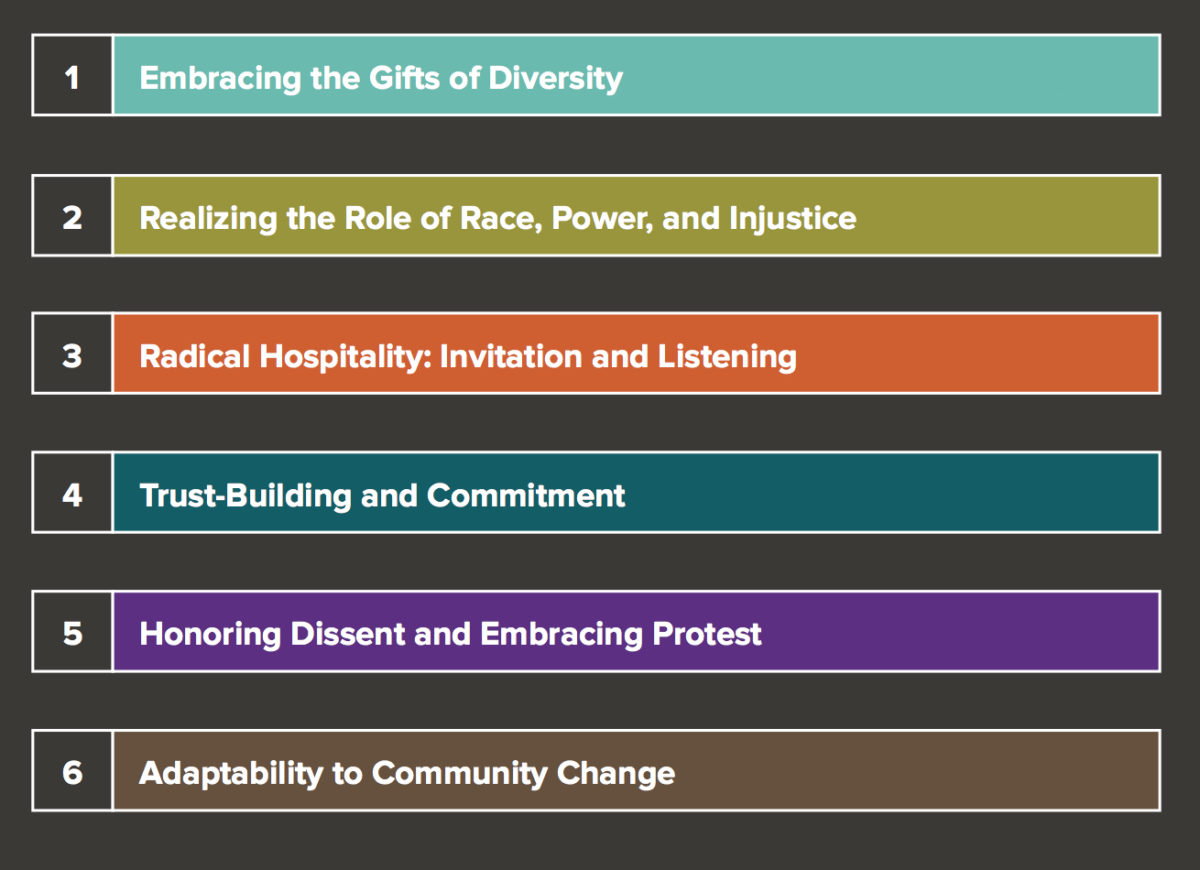
The Six Principles for Equitable and Inclusive Civic Engagement framework was developed by Kip Holley, a researcher, civic-engagement specialist, and community advocate at Ohio State University’s Kirwan Institute for the Study of Race and Ethnicity. The framework is described in The Principles for Equitable and Inclusive Civic Engagement: A Guide to Transformative Change, which was published in 2016 by the Kirwan Institute.
The publication and principles are based on more than a decade of work supporting a variety of organizing and engagement projects in diverse communities across the United States, and on the work described in several previous Kirwan Institute publications, including Growing Together for a Sustainable Future: Strategies and Best Practices for Engaging with Disadvantaged Communities on Issues of Sustainable Development and Regional Planning, Expanding Democracy: A Framework for Bolstering Civic Power and Rebuilding Communities, and Shining the Light: A Practical Guide to Co-Creating Healthy Communities.
“Civic engagement is more than a collection of meetings, techniques, and tools. It takes place in an environment made up of diverse people, practices, conditions, and values. Our civic environments are where we derive our opportunities to succeed. Some communities have healthy, sustainable, and rich civic and built environments. Others suffered from decades of segregation and disinvestment, leaving residents segregated from opportunities and unable to strongly influence the policies that drive community investment.
Kip Holley, The Principles for Equitable and Inclusive Civic Engagement: A Guide to Transformative Change
As a result, residents in these communities have lost the structural and cultural supports necessary to ensure justice and to achieve successful outcomes in their lives. The result is that civic engagement is often viewed as a means of gathering consent for initiatives supported by those with wealth and power, rather than a vehicle for delivering civic power to the community…. For people to exercise their civic power and voice equitably, we must change the way we think about civic engagement, making transformative changes in our longstanding customs, assumptions, and institutions. It also means moving our conversations away from those that foster polarization and towards those that build relationships, foster mutual accountability, and strive for understanding among neighbors.”
In The Principles for Equitable and Inclusive Civic Engagement, Holley explains the Kirwan Institute’s approach to civic engagement, which emphasizes that engagement work cannot be separated from the larger cultural, political, and socioeconomic context in a community, and that the most effective forms of civic engagement must remain responsive to conditions of inequity and injustice:
“We believe that civic engagement is more than just a set of practices; it is also a set of conditions. The civic engagement environment is not only informed by what we practice, but by how we are positioned in our communities. The civic engagement environment exists in the interconnection of our community and individual lives. How we practice civic engagement is tied to our access to resources and opportunities, which is dependent upon the (perceived and intended) motivations behind issue-specific public engagements…. Civic engagement is how we as people make community policies more responsive and ensure that those decisions are beneficial. On one hand, in a democracy, the voices of those who participate most are most likely to be heard and heeded by decision-makers. On the other hand, inequitable access to meaningful civic engagement opportunities can lead to inequitable participation—and thus, unjust investments, conditions, and outcomes.”
Importantly, Holley explains the rationale for adopting a principles-based approach to community engagement:
“When confronted with challenges related to civic engagement, a common response is an attempt to improve participation through a change in technique… [but] techniques alone cannot easily address the decades of community neglect and disinvestment that lead to the distrust, apathy, and inequity that characterize dysfunctional engagement environments. Distrust, apathy, and inequity are challenges that require a transformation in our approach to civic engagement rather than more techniques…. In order to truly transform the civic engagement environment in communities, we must shift from a civic engagement led by techniques to an engagement environment based on inclusive principles, allowing communities to create relevant practices that manifest those principles in the engagement environment. Our experiences have shown that carefully considered and articulated values and principles can act as positive, guiding forces in successful community engagement.”

Read the Organizing Engagement interview with Kip Holly, author of The Principles for Equitable and Inclusive Civic Engagement: A Guide to Transformative Change →
Six Principles for Equitable and Inclusive Civic Engagement
The Principles for Equitable and Inclusive Civic Engagement describe six essential elements of effective civic engagement, particularly in communities of color and communities suffering from the adverse effects of multigenerational poverty and disinvestment. In The Principles for Equitable and Inclusive Civic Engagement, six chapters are dedicated to describing each of the principles in detail. The chapters include discussions of exemplar strategies, related research, and illustrative stories of community groups and organizations in California, Michigan, Minnesota, and Ohio that successfully put the principles into practice.

The Six Principles for Equitable and Inclusive Civic Engagement:
1. Embracing the Gifts of Diversity
The first principle is based on the recognition that “people have a wealth of power in their combined social capital—the networks, norms, and trust that enable participants to act together more effectively to pursue shared objectives.” As Holley writes, “Intentionally using the community engagement environment to build bridging social capital—social capital that is built among diverse community members—has been shown to help create new connections between diverse community members and make resources available within the community, encouraging community members to become involved in the lives of their neighbors. These connections reflect strong attachments to communities and a commitment to making them better places to live for everyone.” Yet social capital requires community members to actively create “an engagement environment that links neighborhood concerns to larger regional or societal issues” so that residents are encouraged to “realize their full potential to change circumstances on a larger stage in the community.”
Characteristics of the first principle:
- A healthy and equitable civic engagement environment is built around gifts that community members contribute and their ability to capitalize on the benefits of creative gifts.
- Communities tend to have many different people who take on leadership roles at various times.
- Social capital can be a powerful source of wealth for communities by making more resources available throughout the community, encouraging neighbor-to-neighbor connections.
2. Realizing the Role of Race, Power, and Injustice
According to Holley, “When community members ignore or avoid the injustices experienced by their neighbors, they risk alienating those whose lives have been colored by them, and losing important knowledge and wisdom to help solve our collective challenges.” Equitable and inclusive civic engagement requires community members to confront histories characterized by racism, classism, and unjust abuses of power. “Power dynamics are often a major factor that shapes one’s experience in a community,” writes Holley. “So it is often impossible to change power dynamics without some disruptions,” and yet “people, no matter how well intentioned, rarely relish giving up power without resistance…. Strengthening our civic engagement practices means honestly confronting resistance to share power from traditionally powerful community members and organizations in communities.”
Characteristics of the second principle:
- Communities are stronger when they recognize and acknowledge the roles that racism and inequality play in the engagement experiences of community members.
- When community members become aware of the power imbalances in their community, they are more able to change those power dynamics by validating the experiences of traditionally less powerful community members.
- Addressing power imbalances within the community often requires significant and challenging changes that will most likely be resisted by those who are the most powerful in the community.
3. Radical Hospitality: Invitation and Listening
“Diverse groups of community members such as young people, new immigrants, returning citizens, and people of color,” Holley writes, “can face tremendous resource barriers to engagement and, as a result, many communities fail to incorporate their voices. For community decisions to be meaningful, community leaders must decide that these voices are integral to the conversation.” Holley calls this intentional decision radical hospitality, which he defines as “more than just inviting people into the community…. hospitality means inviting people to have difficult conversations.”
Holley describes several radical-hospitality strategies, including listening with attention, addressing concerns in ways that are relevant to the community, framing engagements in terms of shared values and opportunity, and cultivating a sense of belonging. This last strategy is especially important in communities with long histories of distrust, disaffection, and disenfranchisement between community members and established institutions of power, such as schools, police departments, or local governmental bodies.
“A sense of belonging is important to everyone,” according to Holley. “Whether the connection is to family members, friends, or co-workers, people want to belong. Unfortunately, there are people in many communities—often people of color and those with lower incomes—who are perceived as not being a full or deserving part of the community, and/or who are purposely excluded.” For example, “Powerful business and government leaders tend to be treated as partners or with deference by community members and policymakers, while people returning from prison, homeless families, racial or ethnic groups, LGBTQ families, and those with low-incomes can be treated very differently.”
Characteristics of the third principle:
- We have found that the best engagement environments strive for a direct and meaningful impact on the concerns of residents from every walk of life, and are undertaken in a manner that is relevant and respectful of all community members.
- For a community to be truly inclusive, community members must be intentional about including the most vulnerable members of the community in a manner that is both inviting and empowering.
- Diverse groups of community members such as young people, new immigrants, returning citizens, and people of color can face tremendous resource barriers to engagement and as a result, many communities fail to incorporate their voices.
- Providing community members a forum for listening to each other’s concerns in a healthy, respectful way is key to an understanding and supportive community engagement environment.
- When community members are dedicated bringing neighbors from all walks of life into the circle of community, their experiences, knowledge, and wisdom can help clarify issues.
4. Trust-Building and Commitment
Distrust is one of the most powerful factors contributing to community disengagement, and equitable and inclusive engagement often requires building—or rebuilding—trust between public institutions, such as local governments or school systems, and the people those institutions serve. “Many people in the communities that we have partnered with,” writes Holley, “feel outright distrust of civic institutions; they report that they have been let down or outright lied to by community officials. In these communities, the engagement atmosphere tends to be fraught with suspicion, doubt, and ultimately, disengagement. Residents have reported that community programs tend to lose support due to the inability of institutions to deliver on their promises, leading to further distrust among residents.”
Two strategies can be particularly effective: shared leadership and shared accountability. According to Holley, “The legitimacy of community outreach efforts is tied to the amount of opportunities that community members have to exercise leadership. This is particularly true in the case of communities that have experienced long-time disinvestment and discrimination. Many people who live and work in these communities are already marginalized in many other facets of life. When this power dynamic presents itself in the community decision-making process, it reinforces a sense of powerlessness, and renders community participation empty and ineffective.”
In addition, Holley writes, “Mutual accountability creates more complete and honest communication between community stakeholders. It encourages shared responsibility and shared learning. In our view, the willingness to share power and responsibility builds trust among stakeholders because it makes real the promise that all stakeholders are seen as valuable, equitable partners in creating the community. Mutual accountability is key to making sure that the agreements made today can withstand political and social changes, and continue to benefit the community. Likewise, vulnerable leadership from those with more power to act within the community, characterized by honesty and humility creates hospitable environments in which trust can be built.”
Characteristics of the fourth principle:
- When community members are able to witness a program or initiative creating real change, they are more likely to stay involved in the community engagement environment.
- When those who are the least privileged in the community are able to demonstrate their skills and abilities in a meaningful way, the community engagement environment becomes a setting where mutual trust can grow.
- Lasting mutual accountability cannot be created by using punitive means to bind stakeholders to promises. Instead the willingness to share power and responsibility builds trust among stakeholders because it signals that all community members are seen as valuable, equitable partners in creating the community.
5. Honoring Dissent and Embracing Protest
For school administrators, institutional leaders, government officials, and elected representatives, the most difficult forms of civic engagement to encourage, support, or sanction are often protests and other public expressions of dissent, criticism, or disapproval. Yet, according to Holley, “the strength of the diversity in our communities relies on our ability to accept and respect our differences. In strong communities, voices of disagreement can actually strengthen the civic engagement environment by offering alternatives and raising tough questions. A diverse set of ideas, visions, and backgrounds within a community are valuable assets. When those differences are expressed, we find out more about our communities and ourselves. By truly honoring dissent, we can create a civic engagement environment where our rich conglomeration of ideas can be brought together in order to build communities that are more than the sum of their parts.” But when local leaders, administrators, officials, and organizers avoid “controversial topics for fear of conflict, they tend to produce the very conflict that they hoped to avoid.”
As Holley writes, “Community challenges cannot be met while withholding our differences. Differences between people will ultimately surface, and then the community is left without the tools to productively navigate them. In order to discuss our differences constructively, authentic forms of dissent must be seen as a form of care, not resistance.” When dissent is based on legitimate community concerns or grievances, then actions such as protests, sit-ins, walkouts, strikes, or boycotts need to be recognized, honored, and embraced.
Characteristics of the fifth principle:
- The strength of the diversity in our communities relies on our ability to accept and respect our differences.
- When communities avoid controversial topics for fear of conflict, they tend to produce the very conflict they hoped to avoid.
- Strong oppositional activities such as protests and boycotts may be able to highlight issues that are difficult to discuss in more traditional engagement settings.
- An engagement environment that supports a space for long-term dialogue and disagreement can help stakeholders stay focused on new possibilities, even while holding different views on issues.
6. Adaptability to Community Change
As Holley writes, “Change is difficult for many of us. Changes in behavior, attitudes, and beliefs require that a person navigate a stressful process of inner psychological adjustment.” And yet communities are always in a state of continual change: “Neighbors move in and out. Businesses close or move on. New technologies, such as television and the Internet, change the way that we communicate and alter how we define our ‘community.’ To be engaged in a community for any amount of time means entering into this difficult process of change, possibly many times.”
In a context of dynamic change, “The community engagement environment must be flexible” and “provide space for people to negotiate the challenging time between when one set of circumstances ends and the other begins,” according to Holley. This is why “focusing on values and principles rather than tactics and activities…can create just the right amount of order needed for a wide variety of dialogues and relationships, without being tied to limiting ideas.”
Characteristics of the sixth principle:
- A healthy civic engagement environment can provide space for people to negotiate the challenging time between when one set of circumstances ends and the other begins.
- In order to create a supportive environment for community change, community members must be willing to try to forgo comfort for truth, and to give up old roles for new roles.
- Honest conversations about civic power, and the potential for abuse and what constitutes legitimate and illegitimate power are important components of ensuring that community changes are equitable and meaningful.
Acknowledgments
Organizing Engagement thanks Kip Holley for his contributions to improving this resource, and the Kirwan Institute for the Study of Race and Ethnicity for permission to reproduce excerpts and images from The Principles for Equitable and Inclusive Civic Engagement.
References
Holley, K. (2016). The Principles for Equitable and Inclusive Civic Engagement: A Guide to Transformative Change. Columbus, OH: The Kirwan Institute for the Study of Race and Ethnicity at the Ohio State University.
Holley, K. & Rogers, C. (2012). Expanding Democracy: A Framework for Bolstering Civic Power and Rebuilding Communities. Columbus, OH: The Kirwan Institute for the Study of Race and Ethnicity at the Ohio State University.
Reece, J. (2011). Growing Together for a Sustainable Future: Strategies and Best Practices for Engaging with Disadvantaged Communities on Issues of Sustainable Development and Regional Planning. Columbus, OH: The Kirwan Institute for the Study of Race and Ethnicity at the Ohio State University.
ISAIAH & The Kirwan Institute for the Study of Race and Ethnicity at the Ohio State University. (2010) Shining the Light: A Practical Guide to Co-Creating Healthy Communities. Columbus, OH: Authors.
Creative Commons

This work by Organizing Engagement is licensed under a Creative Commons Attribution-NonCommercial-ShareAlike 4.0 International License. When excerpting, adapting, or republishing content from this resource, users should cite the source texts and confirm that all quotations and excerpts are accurately presented.